Media | Articles
Cannonball Run Countach roars back into the spotlight, just as it did in the movie
There’s no disputing the jaw-dropping effect that the Lamborghini Countach had on the automotive world. And just as Brock Yates will forever be linked to the iconic Cannonball road race and the hit movie that it spawned, no car exemplifies that 1981 comedy film better than the 1979 Lamborghini Countach LP400 S.
“You think about a car guy in 1981. He has probably never seen a Countach in person. He’s never heard the V-12 scream,” says Ed Bolian, the one-time New York-to-Los Angeles record holder. “And all of a sudden, his senses are just bombarded by that whole experience [in the first four minutes of Cannonball Run]. You’ve got this Lamborghini that comes out of nowhere in the desert, and you’re like, ‘What in the world is about to happen in my life?’”
Plenty. And it happened to more moviegoers than just Bolian, who is one of many enthusiasts who profess their love for the car—and the actual coast-to-coast race that Yates started in 1971—in a newly released documentary by the Hagerty Drivers Foundation, The Cannonball Run Countach: Supercar Legend.
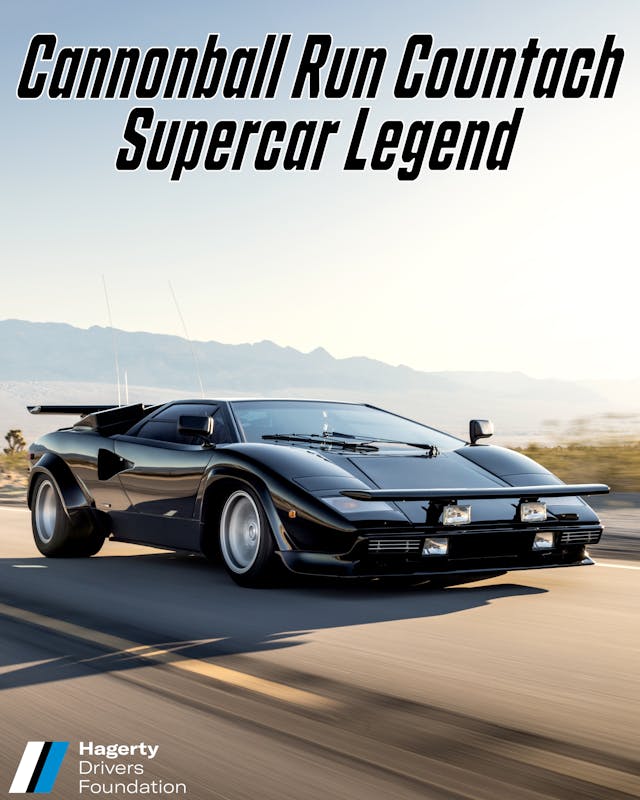
“The reaction is always shock and awe,” says Jeff Ippoliti, the third and current owner of the iconic movie car. “It’s incredible to me. I still can’t believe I own the Cannonball Run Countach. I’ve loved this car for 40 years. It’s certainly the most famous Countach in the world.”
Before the movie, there was the race. Officially called the “Cannonball Baker Sea-to-Shining-Sea Memorial Trophy Dash”—and named for Erwin “Cannon Ball” Baker, who made record runs in cars and motorcycles in the 1920s and ’30s—it was the brainchild of automotive writer Brock Yates, who was sick and tired of the anti-car establishment of the early 1970s. Along with the energy crisis, there was a crackdown on horsepower, and the national speed limit was lowered to 55 mph.
Marketplace
Buy and sell classics with confidence
Yates called BS. Snubbing government officials and political activists like Ralph Nader, “I decided one day that we ought to have a no-holds-barred race from New York to Los Angeles.”
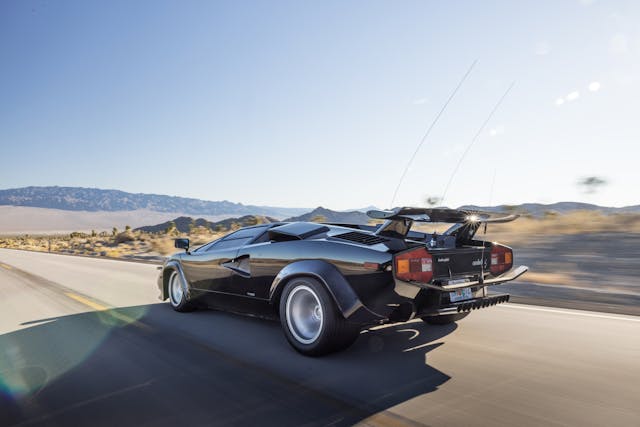
Bill Warner, who participated in the 1975 Cannonball and became the founder of the Amelia Island Concours d’Elegance (now The Amelia), says Yates was “one of the most innovative minds I ever knew.” That, along with Yates’ seemingly endless connections in the automotive world and his fearlessness demeanor, proved the perfect combination to start an event that was considered politically incorrect long before that was even a term. Says Yates’ wife, Pam: “Early on they called him ‘The Assassin’ because he just said what he thought and didn’t care about paying a price.”
Yates proved it time and again in his writing, including this in Car and Driver:
“I suppose half the fun of the Cannonball Baker was anticipating the indignant hen-clucking that would arise in its wake … Let Nader and his ilk maunder inside their air bags. The question arising from the Cannonball Baker and other ‘deplorable crimes’ is not whether we are willing to drive for speed, but whether we are willing to drive for excellence.”
Yates later wrote, “Speed doesn’t kill. Bad drivers do.” He added, “The other guys in the automotive press can sit around and recommend letter writing to your congressmen, but I’ve had it.”
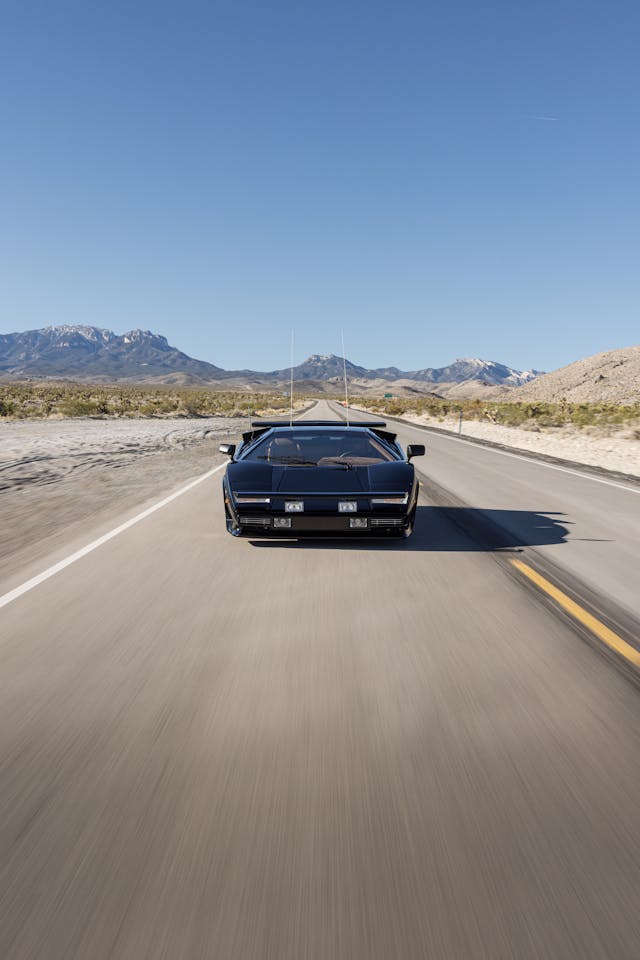
The first 2800-mile Cannonball was set for early 1971. There was no public invitation to take part; Yates was careful to invite competent drivers that he knew. When no one else showed up, Yates decided to make the run anyway, along with his 15-year-old son, Brock Jr., and two others. Driving a 1971 Dodge Custom Sportsman van—not exactly a speed demon—the foursome got lost along the way and ran out of gas once. They completed the journey from the Red Ball Parking Garage on East 31st Street in New York to the Portofino Hotel and Marina in Redondo Beach, California, in 40 hours, 51 minutes.
After writing about the adventure in Car and Driver, Yates threw down the gauntlet again in November ’71, and about a dozen drivers accepted his invitation for what is considered the first official Cannonball. The cross-country run was a lot more difficult than it looked, as teams had to calculate weather, mileage, fuel and bathroom stops, equipment, and food … all while following a route penned on an actual paper map. Appropriately, Yates and teammate Dan Gurney won in a Ferrari Daytona, finishing in 35:54.
About the same time, the first Lamborghini Countach was unveiled to the world at the Geneva Auto Show. The wedge-shaped supercar created quite a stir, as it was nothing like anyone had ever seen.

John Temerian, a vintage supercar expert and founder of Curated, says legend has it that when a security guard laid eyes on the new Lamborghini, he exclaimed Countach!—“which essentially meant ‘Holy shit!’”
The Countach made a bold statement, not only to the driver but to everyone who came in contact with it. It followed a line of successful Ferruccio Lamborghini automobiles, beginning with the automaker’s first two production cars, the 350 GT and the Miura P400. However, Countach designer Marcello Gandini admits, “The Countach was the desire to separate ourselves from this past.”
It was different alright, but also timeless: intricate tubular chassis, V-12 engine that generated almost 400 horsepower, swing-up doors …
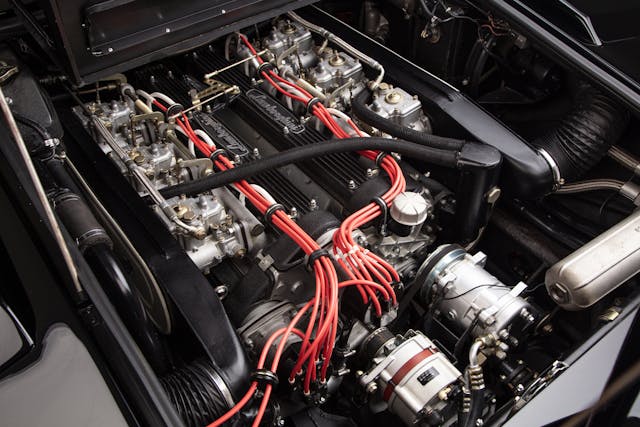
While the world mostly read about and admired photos of the Countach, the Cannonball also continued in the shadows, while Yates told the story in those same car magazines. In 1975, Jack May and Rick Cline drove a 1971 Ferrari 246 Dino to victory and lowered the time to 35:53, but some of the best stories involved teams looking for an edge. For instance, Peter Brock and three others disguised themselves as priests, which came in handy after they were stopped by the police.
“Cannonball is the kind of thing that [when] anybody hears about it [they say], ‘That sounds like a movie,’” Bolian says.
Others thought so too. In fact, the Gumball Rally movie predated Cannonball Run by five years. Yates, who had been asked to help write Smokey and the Bandit II, wasn’t happy that someone had stolen the story, but he also knew he could do it better. The film remained on the backburner, however, while the actual Cannonball continued.
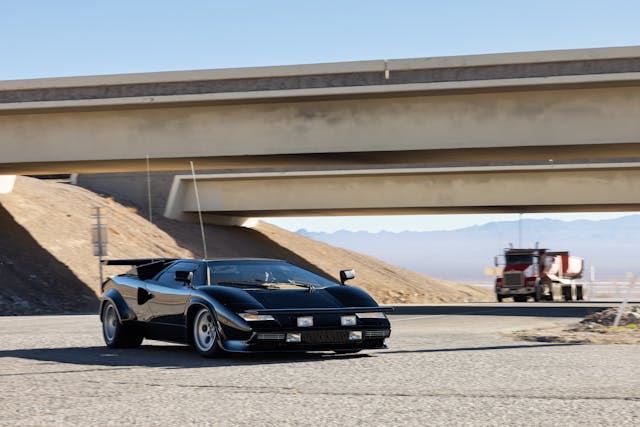
In the 1979, Yates and teammate Hal Needham (who eventually directed Cannonball Run) drove an ambulance and dressed as PMTs, hoping that police would look the other way. They didn’t. In fact, Yates and Needham were stopped almost immediately by New Jersey state troopers, who asked where they were headed. Yates immediately answered, “Los Angeles.” The cops were puzzled and asked why they didn’t fly there. Yates had planned for just such a moment and had invited a real doctor to come along. With Pam Yates acting as the patient, her eyes tightly shut, the doctor explained that “the senator’s wife” had a rare condition that didn’t allow her to fly. They were waved on and sped away.
David Heinz and Dave Yarborough won that year, driving a 1978 Jaguar XJ-S and lowering the record time to 32:51. The race would be the last real Cannonball.
Yates decided to end it after he met Terry Bernius, who had excitedly purchased the black 1979 Lamborghini Countach LP400 S Countach that would later appear in the movie and vowed to drive it in the Cannonball.
“That car killed the Cannonball,” Warner says. “The light went off in Brock’s head and he says, ‘These cars are getting too fast for us. It’s gotten out of hand.’”
And just like that, the Cannonball was over. Yates turned his attention to the movie script, and although the Countach never took part in the actual race, it became the star car of the film. One of only 105 built that year and capable of 205 mph, the Countach became an aspirational car for enthusiasts across America.
One such enthusiast was Ron Rice, founder of Hawaiian Tropic sun care products. Rice was an early proponent of product placement, and he paid to have Hawaiian Tropic shown on screen. He was also allowed to hang out on the set, and upon seeing the Countach for the first time, he immediately bought it from Bernius.
Steve McQueen was originally cast for the lead role in Cannonball Run, but when he was diagnosed with cancer, Burt Reynolds took his place. That changed the entire complexion of the movie. With Reynolds’ influence, the script became more farcical, and the cast kept growing. “Everybody wanted to get in on the fun,” Pam Yates says.
The star-studded lineup included Farrah Fawcett, Dean Martin, Sammy Davis Jr., Roger Moore, Bert Convy, Jamie Farr, Jack Elam, Bianca Richards, Jackie Chan, Peter Fonda, Adrienne Barbeau, Mel Tillis, Terry Bradshaw … and even Pam Yates. “If you hung around long enough,” she says, “you were in the movie.” Brock Yates also appears.

The Countach, of course, became the biggest star on four wheels, and it’s easy to see why. Jeff Ippoliti points out that first four minutes of Cannonball Run marked “the first time most people got to see the Countach move.” And they were impressed—maybe not as much as Rice or Ippoliti, but impressed just the same.
“The iconic sound of that car,” Tamerian says. “There was nothing like it.”
Adds Brett David, CEO of Prestige Imports Lamborghini Miami: “Just that screeching halt in front of the 55 [mph sign in the opening scene]. I mean, that’s just everything.”
Pam Yates says that scene has special meaning to her. “One visual brought together Brock Yates’ philosophy on life and driving … the crossing out of the 55 mph speed limit.”

The movie car came into Ippoliti’s ownership after he asked Rice whether he would consider bringing it to an event for the Make-A-Wish Foundation, an organization in which Ippoliti is heavily involved. Before long, the two were negotiating a sale. It took two years before they settled on a price. Ippoliti admits that when he drove away in the car, he was listening to the Cannonball Run soundtrack.
Ippoliti had a two-year restoration done on the Countach because he wanted it to look “exactly the way it looked in the movie—exactly the way it looked when I first saw it as a teenager.” Although that meant completely new upholstery, most of the car was simply disassembled, refinished (or repainted), and reassembled.
The Countach is no trailer queen, however. Ippoliti and his wife drive it often. “I still can’t believe it’s in my garage,” he says.

The Cannonball was never officially held after the ’79 race, but Cannonball enthusiasts weren’t ready to give up the idea. David Diem and Doug Turner, driving a Ferrari 308, won the “1983 U.S. Express” in 32:07. Thirty years later, in 2013, Ed Bolian, Dave Black, and Dan Huang drove the route in a 2004 Mercedes-Benz CL55 AMG and established a new record of 28 hours, 50 minutes. It stood for six years until November 2019, when some friends of Bolian’s drove a 2015 E63 AMG to a record time of 27:25.
Then the pandemic hit in early 2020 and the world was shut down. Fewer cars meant less traffic, and in the first three months of the pandemic, the New York-to-Los Angeles record was broken an astounding 12 times. The current record holders are Arne Toman, Doug Tabbutt, and Danadel Daryoush, who drove a 2016 Audi S6 and completed the route in 25:39.

Still, thanks to the movie, no automobile conjures images of the iconic Cannonball more than that black Countach. While more than 1900 were built over 17 model years, Ed Bolian reasons that “if you had to pick one that defines everything that the car ever wanted to stand for, you can’t do any better than this car.”
Temerian also puts the Countach—all Countachs, actually—on a pedestal. “It was almost like magic when that car was created. It’ll never happen again. It was just perfection—on that day and in that moment. That’s what the Countach is.”
In September 2021, the Cannonball Run Countach was officially added to the National Historic Vehicle Register by the Hagerty Drivers Foundation. Its history will be forever archived in the Library of Congress … and also on the movie screen.
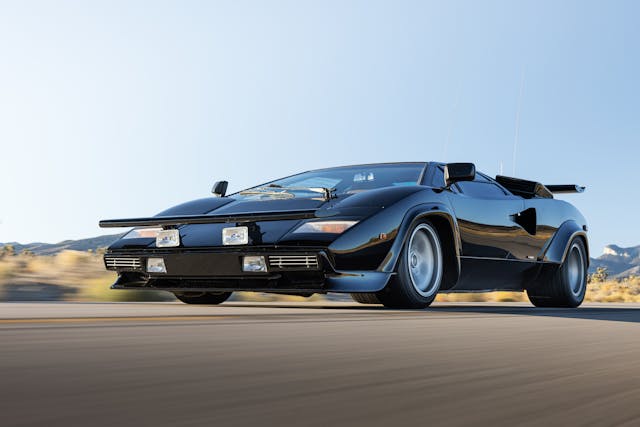










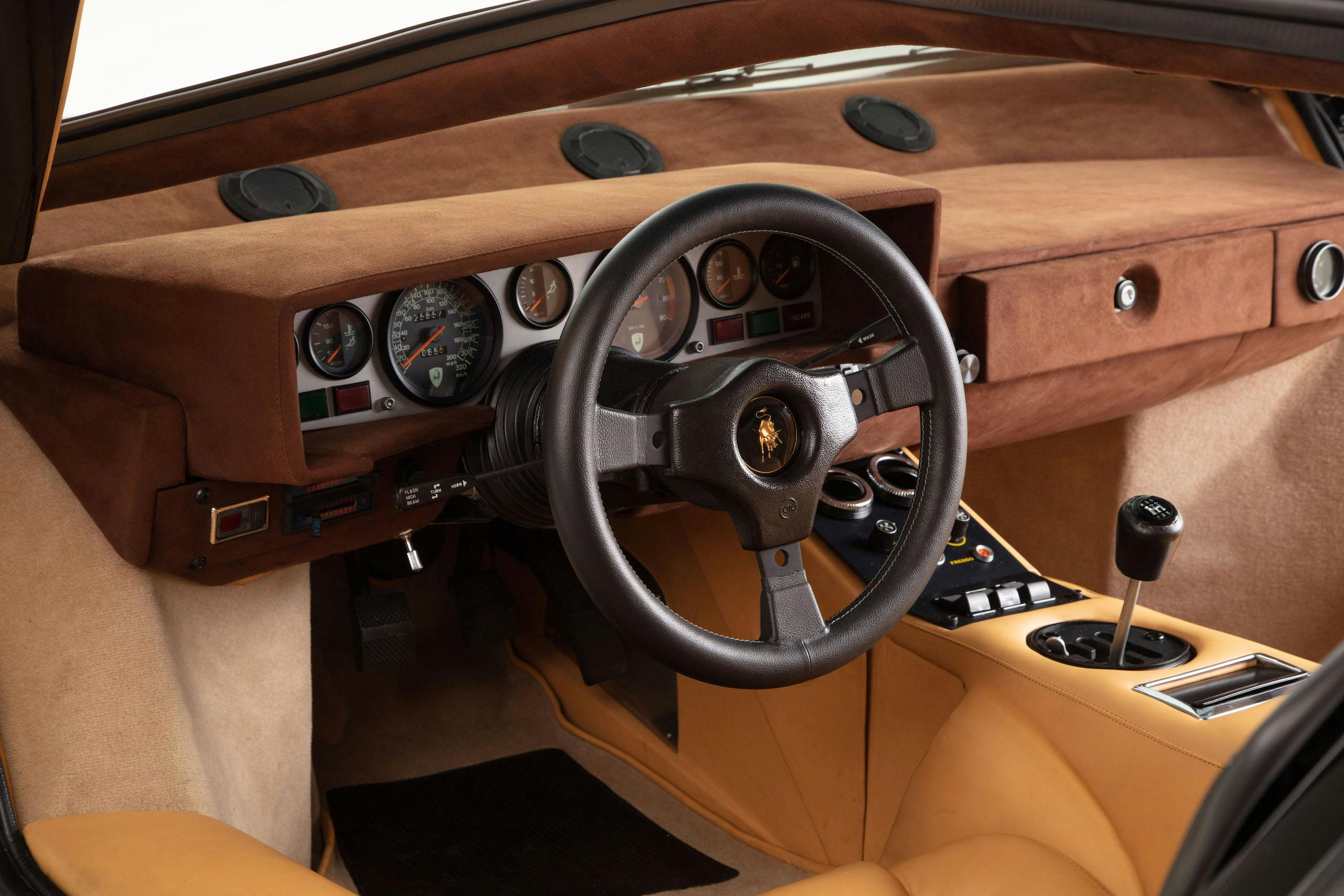









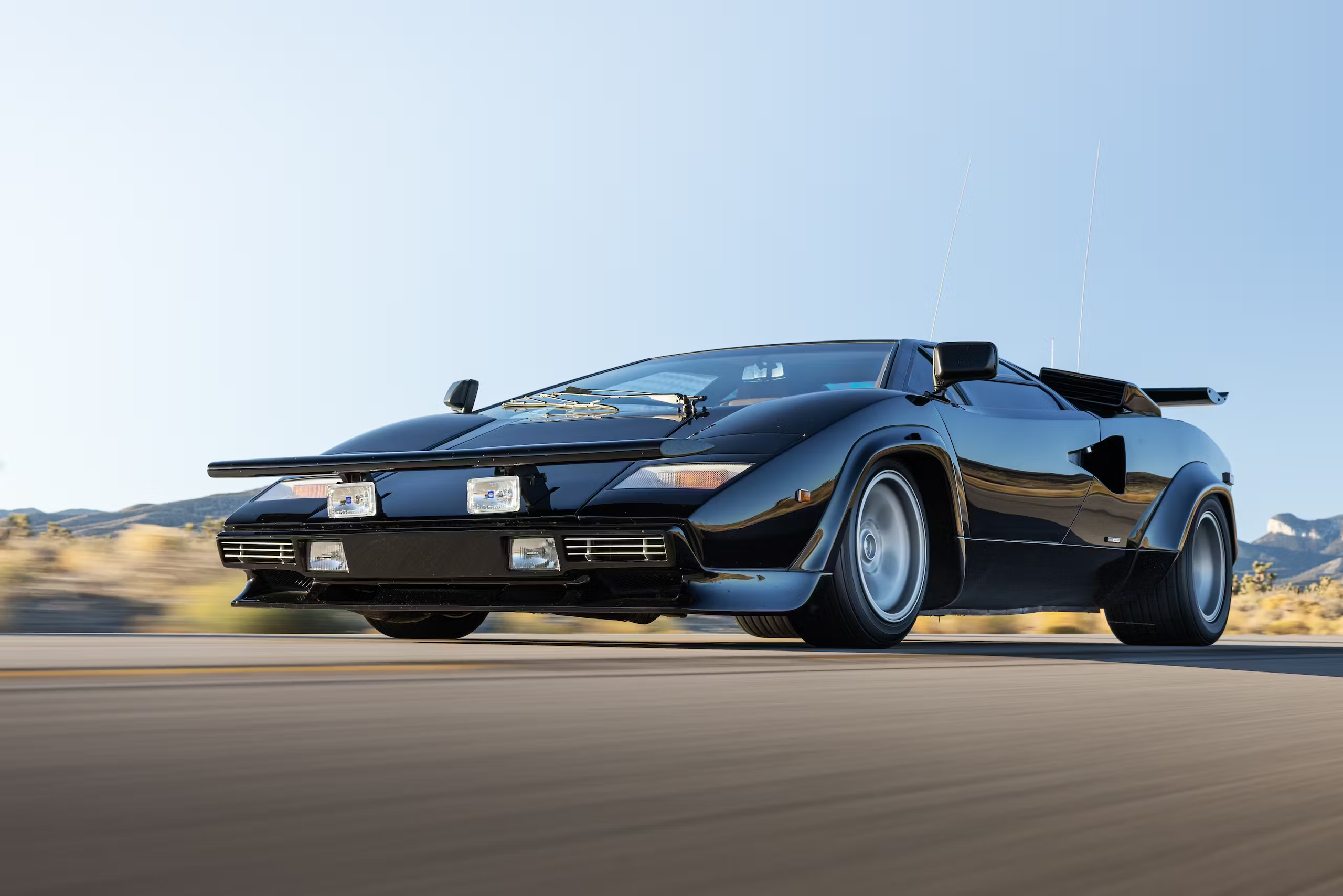
Hagerty needs to hire a professional proof reader. That Countach cannot do 205 mph. Even without the ridiculous front wing.
Correct. The LP400S is actually the slowest Contach made, with a top speed of 158 mph.
“One of his most frequent exclamations was ‘countach’, which literally means plague, contagion, and is actually used more to express amazement or even admiration, like ‘goodness’. ” – Marcello Gandini.